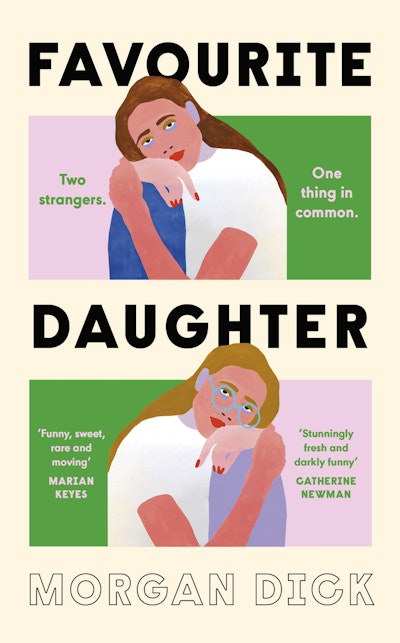From being a step-sibling to her up-close experience with addiction, Morgan’s real life played a role in shaping Favourite Daughter.
Where did the idea for Favourite Daughter come from?
The idea was partly inspired by watching my own dad, an adoptee, meet his ‘long-lost’ siblings when he was in his fifties. The experience sparked my curiosity about the things two half-siblings might share – not just their noses or eyebrows but also their habits, hobbies and even vices – despite having been raised apart.
As someone who works in the mental health field, I could think of no better place for these discoveries to unfold than inside a therapy room. My brother is a recovering alcoholic, and the impact his illness had on our family really can’t be overstated. It also prompted an ongoing question for me: whether people who are struggling can ever truly get better. I believe they can – and I hope the book shows that!
Who was your favourite character to write?
Although Mickey, the sister who’s sent to therapy as a condition of her father’s will, initially came more naturally to me, I’d have to say Arlo was ultimately my favourite! As the therapist, she holds most of the power at the outset of the relationship. She’s a character who, while seemingly put-together on the outside, is actually a huge mess on the inside. But aren’t we all?
I also loved writing the character of Ian, who’s one of Mickey’s kindergarten students, simply because (like all five-year-olds) he’s a huge weirdo.
What kind of research did you do for the book?
I had a lot of frank conversations with my brother about his addiction, which really helped me shape the character of Mickey. He’s always so generous about sharing his experiences. I feel incredibly grateful to him for that. I also did a lot of reading about adult children of alcoholics and some of the specific challenges they might face.
Are there any books/authors/artworks that influenced you writing?
Oh, I could go on forever talking about this! But I’ll try to brief.
I’m always inspired by stories that feature flawed, messy women, like Meg Mason’s Sorrow and Bliss and Natalie Sue’s I Hope This Finds You Well. I rewatch Fleabag at least twice a year. Same goes for Russian Doll. I’m also drawn to stories about big, complicated families, like Rebecca K Reilly’s Greta and Valdin, Ann Patchett’s Commonwealth, and Kevin Wilson’s The Family Fang.
What’s your #1 tip for aspiring authors?
My best advice is to have fun! Any writing project takes a lot of time and patience, and you’re so much more likely to finish the thing if you’re enjoying yourself. Not to say that writing is easy – it definitely isn’t – and there are plenty of days where I want to hurl my laptop into the sea. But in general, we should be having a good time when we write. Why else are we doing it?
A fact or tid-bit you think might help readers understand your book better?
Another reason I was drawn to writing about half-siblings is because I have two myself! (We all grew up together though, so I think of them more as full siblings.)
What surprised you most about the publishing process?
I wouldn’t say this was a surprise exactly, but I was amazed by how much the book improved with professional editors on my side. I was the kid in school who hated group projects, so I’m not super naturally inclined toward collaboration – but I’ve really learnt to embrace it. It can be hard to receive feedback on something that’s so close to your heart, but you really can make a piece of writing so much better by involving others and hearing what they have to say.
What advice would you give to someone who’s currently working on their own debut novel?
I’ve learned that it’s important to take breaks. (Ugh, I know – lame.) This means that I don’t write every day, and I try to wait a few weeks after finishing one draft before diving back in again. I’m the type of person who always wants to rush through things, but I’ve learnt that if I slow down and give myself time to recharge, the work gets so much better. (And there’s less of the aforementioned laptop-hurling.)














